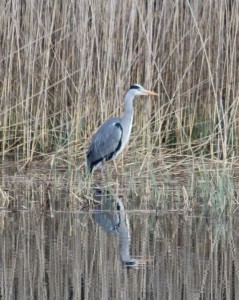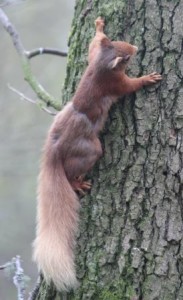Osprey Update 16th May – Energy Eggonomics
The latest series of osprey intrusions has had the nesting pair in a bit of a flap this week. The nesting pair has been kept busy defending their realm from these unwelcome visitors, as well as from geese and gulls!
Energy and time expended in defending the nest creates a deficit in the fishing budget. The regularity and frequency of fish deliveries has been noticeably disrupted and the female, that we have come to recognise as patient and demur, has often been heard food begging. She has not been recorded bringing her own fish to the nest, which tells us that the male is still doing enough to sate her appetite. The male continues to bring sticks, moss and turf to the nest, sometimes in comical fashion. His trademark delivery is the unceremonious dropping of the lichen encrusted stick on the female’s back while she is incubating! Some of this material will be needed to maintain the nest and alter its structure once the eggs are hatched to aid fledging. It is also a continuation of bonding behaviour. Sticks, however unwieldy the delivery, are tokens of courtship. This behaviour should change once eggs have hatched and the male must then invest his resources in feeding the brood.
Unlike the unwanted gulls and geese, grey herons generally reside peacefully alongside ospreys. One of the herons at Lowes has been showing well on the edge of the reed bed very close to the nest. They are well known for their motionless fishing poise that can fool an observer into believing they are watching a decoy. They are voracious hunters and will take almost any live prey of suitable size. They do not trouble the ospreys as they are not competing for the same fish. In late medieval Scotland hunting herons with peregrines was popular sport amongst the nobility. Poaching a ringed bird was punishable by amputation of a hand!

Finally, a group of visitors was charmed and enthralled by the sight of two of our red squirrels chasing one another in a spiral around a tree in the feeding area. This is classic courting behaviour between a male and female. Sightings are becoming more frequent and the visitor centre staff have recently noticed a female with swollen nipples. The evidence points to the enticing possibility of infants in the drey. Weening for red squirrels is at about 10 weeks, so watch this space!

Alex,
Species Protection Officer.
Help protect Scotland’s wildlife
Our work to save Scotland’s wildlife is made possible thanks to the generosity of our members and supporters.
Join today from just £3 a month to help protect the species you love.
Preface
The latest series of osprey intrusions has had the nesting pair in a bit of a flap this week. The nesting pair has been kept busy defending their realm from these …
